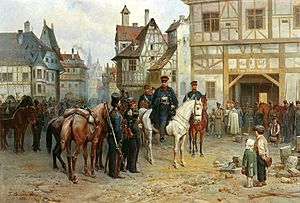Battle of Bautzen (1813) facts for kids
{{Infobox military conflict | conflict = Battle of Bautzen | image = Battle of Bautzen 1813 by Bellange.jpg | image_size = 300 | caption = Napoleon on white horse surrounded by his officers, receives a messenger. | partof = the German campaign of the Sixth Coalition | date = 20–21 May 1813 | place = Bautzen, Kingdom of Saxony | coordinates = 51°11′00″N 14°25′00″E / 51.1833°N 14.4167°E | result = French victory | combatant1 = ![]() France | combatant2 =
France | combatant2 = ![]() Russia
Russia
![]() Prussia
Prussia
| commander1 =
| commander2 =
 Peter Wittgenstein
Peter Wittgenstein Alexander I
Alexander I Barclay de Tolly
Barclay de Tolly Mikhail Miloradovich
Mikhail Miloradovich- Template:Country data Grand Duke Konstantin Pavlovich of Russia
The Battle of Bautzen was a major fight in Germany. It happened on May 20-21, 1813. Napoleon and his French army fought against soldiers from Prussia and Russia. The Prussian army was led by General Gebhard Leberecht von Blücher. The Russian army was led by General Peter Wittgenstein. These two armies were much smaller than Napoleon's. They had just lost a battle at Lützen. Napoleon pushed them back, but they managed to get away. Some people say this was because one of Napoleon's generals, Michel Ney, made a mistake.
Getting Ready for Battle
The Prussian and Russian armies were retreating after their loss at Lützen. But then, Tsar Alexander I of Russia and King Frederick William III of Prussia told them to stop. They were to make a stand at Bautzen.
The combined Prussian-Russian army had about 96,000 soldiers. Napoleon, however, had a much larger force of about 144,000 men. General Wittgenstein set up two strong defense lines. These lines were east of the River Spree. The first line used villages and hills for protection. The second line protected the bridges behind a river bend. The town of Bautzen protected their left side. Several lakes protected their right side.
Napoleon planned to keep his enemies busy on the first day. Then, he wanted to trap them with Marshal Michel Ney's troops. Ney's troops were supposed to arrive the next day. But Napoleon got some wrong information. He thought the Prussian-Russian army was bigger and stronger than it was. So, Napoleon decided to wait and weaken them first before setting his trap.
The Battle Begins
The battle started around noon with a huge bombardment. Napoleon's big cannons fired for hours. After much fierce fighting, the French broke through the first defense lines. They took control of the town of Bautzen. The Prussian and Russian soldiers fell back in an orderly way.
By nightfall, the French were trying to cut off the enemies' escape route. But the Prussian and Russian leaders knew that Marshal Ney was getting close to their right side. However, Marshal Ney got confused. His troops ended up in the wrong place. This mistake left a way open for the Allied armies to escape.
Second Day of Fighting
The fighting on May 21, the next day, was very tough again. After some early problems, the French attacks started to get stronger. But these attacks were only meant to keep the Allies in place. Napoleon wanted to trap them and surround them.
Once more, Marshal Ney got sidetracked. He decided to capture a village called Preititz. Because of this, he forgot about the main goal. The main goal was to cut off the Allied armies.
The Russian and Prussian armies were being pushed back. At 4:00 PM, the Tsar realized the danger from Ney's troops. He knew the battle was lost. So, he ordered a full retreat. But because Ney's forces didn't block their way, the Allies escaped. Napoleon had hoped for a crushing defeat, but it didn't happen.
Both sides lost many soldiers, around 20,000 in total. Some reports say the French lost even more because of their aggressive attacks. The Allies might have lost fewer, perhaps 11,000 to 14,000. Because of this, the French victory at Bautzen is sometimes called a Pyrrhic victory. This means it was a victory that cost too much. Napoleon had more soldiers, so it was a missed chance for him to win big.
What Happened Next
Even though the French won, Bautzen was not the big victory Napoleon wanted. Marshal Ney's failure to cut off the retreat meant Napoleon didn't get a complete win. Again, Napoleon had to settle for a difficult and costly victory. Over 20,000 French soldiers were hurt or killed.
To make things worse, Napoleon's close friend, General Geraud Duroc, was badly wounded. A cannonball hit him the day after the battle. He later died. After Bautzen, Napoleon agreed to a nine-week break in fighting. The Allies asked for this truce on June 2, 1813. The Armistice of Pläswitz was signed on June 4. It lasted until August 10. Napoleon hoped to get more soldiers and train his new army better. But the Allies also used this time to get stronger. When the fighting started again, Austria joined the Allies. It is said that Napoleon later regretted agreeing to this truce. He felt it helped his enemies more than it helped him.


